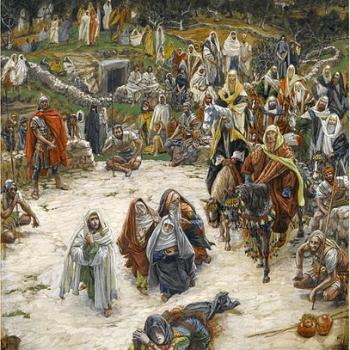This weekend, when I was hosting a debate on “R: Send Your Children to Public Schools” one of the speakers said she thought the most destructive assumption of the public school system was that children should all be partitioned into same-age groups, moved about in those sets, and that any cross-age interaction is abnormal and disruptive. (I’ll note that this tends to hold for most non-public schools as well). Critics of homeschooling tend to bring up worries about “not being socialized” but, as my friend pointed out, the kind of socialization we set up our schools to promote is odd. And novel.
The Boston Globe would argue that, once we’re out of school, with its age-linked grades, age segregation isn’t de jure (though there are more exceptions than you might expect) but it does remain in effect de facto, with pernicious consequences:
Senior citizens live in nursing homes where they mainly see other very old people, while new retirees now often buy condos in age-segregated communities where younger people aren’t even allowed to live. Adolescents, who in a previous era might have spent significant time around adults while farming, apprenticing, or helping with the family business, spend their after-school hours on social media, talking mostly to one another. It is possible, today, for a middle-aged office worker to go to sleep on a Friday having interacted all week with not one person more than a decade older or younger; the same could well be true for her daughter in college, or her parents living at Pleasant Oaks Village. According to one study, Americans over 60 said that only a quarter of the people they had discussed “important matters” with during a six-month period were younger than 36; if they didn’t count relatives, the number dropped to an astonishing 6 percent.
…Age segregation can even have costs among more closely linked groups. A study by husband and wife anthropologists Beatrice and John Whiting looked at age-mixing among children in six different cultures, and found that older kids who spent time with younger ones learned to be nurturing, while the younger ones learned valuable lessons about how to be part of a system where they were less dominant. Kids who only played with their exact peers, on the other hand, learned to be competitive.
“We have a lot to learn from people who are in different phases of life than us,” said Barbara Rogoff, a psychologist at the University of California Santa Cruz who has studied age segregation for many years.
Rogoff said she is particularly concerned about kids in modern America. People “think of children as having a whole different life than adults,” she said, “but that’s not necessary, or even a common way for children to grow up.” One study, conducted by University of Arizona anthropologist Alice Schlegel, looked at 186 pre-industrial cultures around the world and compared them based on the amount of interaction kids had with adults outside their family. Schlegel concluded that “age segregation was related to features of antisocial behavior and to socialization for competitiveness and aggressiveness.”
Rogoff, for her part, has compared the relationship between kids and adults living in West Newton and the Guatemalan town of San Pedro. She found that the Guatemalan children spent a lot more time around adults who were doing work, and frequently emulated work in their pretend-play—for instance, making imaginary tortillas out of dirt. In West Newton, Rogoff said, children seldom saw adults working, and time spent with parents was more often devoted to “child-focused activities” and conversations about “child-related topics.” “We’ve overdone it,” Rogoff said. “We wanted to protect kids from working in factories 100 years ago…but we have excluded so much from the life of the community that they don’t feel like they have anything to contribute, and they don’t have as much opportunity to learn.”
One of the suggestions the article makes is blending college towns with senior centers, so that it’s easier for the elderly to audit classes and join the university community. There are fewer suggestions for how to integrate working adults with the elderly or the young (or even differently aged working adults). Presumably, some of the urban design discussed by Jane Jacobs in The Death and Life of Great American Cities (strongly recommended) could help get people out of their houses and into relationships with their neighbors in neighborhoods where people do live in mixed-age neighborhoods, but don’t interact.
Personally, I mostly encounter people outside my narrow age range only at church (and that still tends to be brief, “How old are your kids? What a shayna punim” encounters). It means I see a narrower slice of ways to live than I would if my social circle were more diverse age-wise (or even if the people in my age bracket were a little more diverse in their activities — I have a lot of friends in law school, and only one with a child). I tend to learn more about what I might be or do when I grow up from reading, with all the bias that method of observation entails, than by interacting with older adults and being integrated into their lives.
Maybe age segregation is part of what drives the popularity of Mommy Blogs. I like reading Libby Anne’s Love, Joy, Feminism (see here for a particularly good post) because it offers me a lens into what it’s like to raise children thoughtfully and lovingly. It’s not just that I might one day need to know this for my own hypothetical kids, but that I think I learn more about how to interact lovingly with children and just with people by taking a closer look at this particular class of relationships–interactions that don’t crop up naturally in my 20-something life.
At our public schools debate, we wound up having more age-integration than usual, when a mother in my apartment building stopped by and asked if I’d mind if her 12-year-old son sat nearby to eavesdrop. (We debate on the roof, and they’d apparently enjoyed our debate the previous month). Naturally, we invited the middle schooler to join us, and he asked some questions and made a speech himself. If I had been hosting the debate in my living room, rather than one of the common spaces of my building, I wouldn’t have known he was interested, and his mother wouldn’t have had the opportunity to ask. We all got lucky.
I’d like to rely on luck less often, and I plan to put a little more work into thinking what I can do, within my apartment building, to offer hospitality and to create opportunities for new relationships, with people that my current life doesn’t introduce me to. Have any readers had luck in fostering community in ten-story buildings? Or have any clever ideas to try out?
The easiest thing seems to be baking on a weekend, and then putting a notice in the elevator (or just on my floor) that there are fresh-from-the-oven cookies available. Odder things might include finding a way to be useful to a particular group of people within the building (probably can’t run an Estes rocketry class from an apartment, though). Your thoughts?
Today is the eighth day of a novena to St. Therese of Lisieux, timed to end on her feast day (Oct 1), which is also the One Rose Invitation Day, sponsored by Imagine Sisters
















